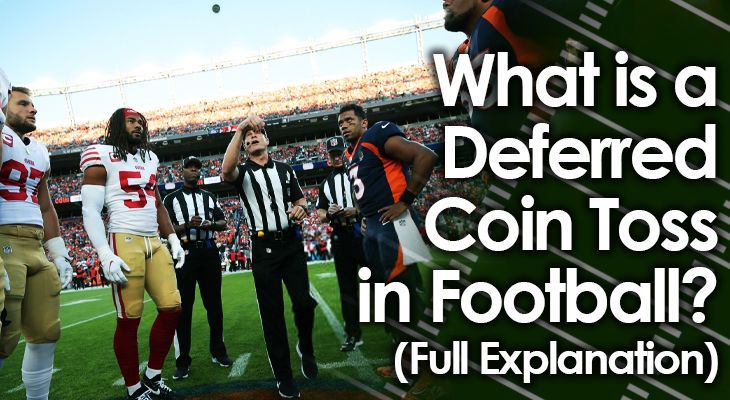Football is a game filled with a multitude of terms and strategies that may seem puzzling to those new to the sport. One such term that often raises questions is “deferring” in football. What does it mean to defer in football? On the surface, it might appear simple, but its implications can have a significant impact on the game. In this blog post, we will dive into the intricacies of this strategic move, exploring when and why teams choose to defer, how it can affect momentum, and the advantages it offers. By the end, you will have a clear understanding of the importance of deferring in football and its role in shaping the dynamics of the game.
Introduction to Football Deferment
Understanding what it means to defer in football is crucial for fans and players alike. When a team wins the coin toss at the beginning of a football game, they have the option to choose whether they want to kick off or defer their choice to the second half. In football terms, deferring means that the team that wins the toss decides to delay their decision on whether to kick off or receive the ball until the start of the second half.
Importance of Deferring Strategy
One key strategic advantage of deferring in football is the opportunity to have possession of the ball at the start of the second half. This can be advantageous if the game is tied or if the team is trailing by a small margin at halftime as they get a chance to score points and potentially shift the momentum in their favor.
Additionally, deferring can also give teams more flexibility in planning for the game. By deferring, teams can assess how the first half unfolds and make informed decisions based on the game situation.
Strategic Moves After Deferring
After choosing to defer, teams often strategize their play calling and game plan accordingly. Coaches may adjust their tactics based on the score, weather conditions, player performance, and various other factors to maximize their chances of winning the game.
- Halftime Adjustments: Teams that defer can make specific adjustments during halftime to counter their opponent’s strategies and capitalize on any weaknesses they observed in the first half.
- Momentum Shift: Possessing the ball at the beginning of the second half can create a positive momentum shift for the team, motivating players and energizing fans.

Historical Context of Deferring in Football
In football, the concept of deferring refers to a team’s decision to choose whether to kick off or receive the ball at the beginning of a game. This strategic move can have a significant impact on the game’s outcome, as it allows teams to control field position and momentum right from the start.
Origins of Deferring
The practice of deferring in football dates back to the late 20th century when coaches began realizing the advantages of having the option to start either the first or second half with the ball. By deferring, teams can adapt their game plans based on the flow of the match, weather conditions, and other factors.
Impact on Modern Gameplay
As the game of football has evolved, the strategy of deferring has become a common practice among teams at all levels of play. It provides teams with greater flexibility and control, allowing them to make informed decisions based on real-time circumstances.
- Field Position: Deferring can help teams gain an early advantage by choosing the favorable side of the field or sun direction.
- Momentum: By deferring, teams can set the tone of the game by scoring first or making a defensive stand right from the kickoff.
Strategic Advantages of Deferring
When a team defers at the coin toss in a football game, they opt to delay their choice of receiving or kicking off to the second half. This strategic decision can offer several advantages to the team, allowing them to control crucial game moments and gain momentum.
Field Position Advantage
By deferring, a team can potentially choose which end zone to defend based on the wind or sun conditions, granting them an early edge in the game.
Moreover, starting the second half with possession can enable the team to set the tone for the rest of the game by mounting pressure on their opponents.
Halftime Adjustments
Deferring also gives the team the valuable opportunity to make halftime adjustments based on the first-half performance of both teams. This allows them to adapt their tactics and exploit their opponent’s weaknesses effectively.
- Coaches can analyze the first-half plays to devise a more effective game plan.
- Players can rest and recuperate, ensuring peak performance in the crucial second half.
Understanding the Decision-Making Process
When we talk about football and the decision to defer, it’s crucial to understand what it means for a team strategically. In football, the decision to defer is the choice to give the opposing team the first possession of the ball after the coin toss at the beginning of the game.
Importance of Deferring in Football
Deferring in football can provide teams with a significant advantage. By deferring, a team gets the opportunity to choose which side of the field they want to defend or kick from in the second half. This decision can be strategic, especially if weather conditions or field positions play a significant role.
Strategic Considerations
Coaches often weigh various factors when deciding whether to defer or not. Factors such as weather conditions, the strength of their defense or offense, and the momentum of the game can all influence this decision. Teams may choose to defer to gain an edge in the second half when it matters most.
Moreover, deferring in football can psychologically impact the opposing team, putting pressure on them to perform well in their first possession. This strategic move can disrupt the rhythm of the opponent’s game plan and give the deferring team an opportunity to control the momentum.

Impacts on Game Dynamics
Understanding the concept of deferring in football can significantly impact the game dynamics. By choosing to defer the coin toss, a team can gain a strategic advantage in the game. This decision allows the team to choose which end zone to defend or receive the ball in the second half, giving them the opportunity to control the momentum of the game at crucial moments.
Enhanced Tactical Options
Deferring provides teams with the flexibility to adjust their game plan based on various factors such as weather conditions, player performance, and opponent strategies. This strategic choice enables teams to adapt their tactics during halftime, making it harder for the opposing team to predict their moves.
Additionally, deferring can disrupt the rhythm of the opposing team, forcing them to make adjustments on the fly and potentially making them more vulnerable to errors or turnovers.
Psychological Advantage
Psychology plays a crucial role in sports, and deferring can have a psychological impact on both teams. The team choosing to defer may exhibit confidence in their abilities to perform well in the second half, while the team receiving the ball initially may feel pressured to make a strong start to the game.
This psychological advantage can influence the momentum of the game and affect the morale and mindset of the players, ultimately influencing their performance on the field.
Frequently Asked Questions
-
- What does it mean to defer in football?
- To defer in football means that a team chooses to defer their choice of kicking off or receiving the ball until the second half of the game, after the other team has made their selection.
-
- Why would a team choose to defer in football?
- Teams often choose to defer in football to gain strategic advantages. By deferring, a team gets to choose which direction they want to play in the second half, can adjust their game plan based on the first half performance, and potentially have back-to-back possessions at the end of the first half and start of the second half.
-
- When can a team decide to defer in football?
- The decision to defer in football is made during the pregame coin toss. The team that wins the toss can choose to defer their choice to the second half.
-
- Is deferring in football a common strategy?
- Yes, deferring in football is a common strategy used by many teams, especially in professional leagues like the NFL. It is seen as a way to gain a competitive edge and control the flow of the game.
-
- What are the benefits of deferring in football?
- The benefits of deferring in football include having more control over the game’s momentum, potential strategic advantages, and the opportunity to make adjustments based on the first half performance.
Closing Thoughts
In summary, understanding what it means to defer in football is key to mastering the game’s tactics and strategies. By deferring the choice between kicking off or receiving the ball to the second half, teams can gain a competitive edge and control the momentum of the game. It allows teams to adapt their gameplay based on the flow of the match and exploit their opponent’s weaknesses effectively.
Remember, deferring is not just a simple coin toss decision but a strategic move that can set the tone for the entire game. So, next time you watch a football match, pay attention to which team chooses to defer and how it impacts the game dynamics.





